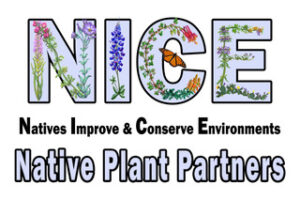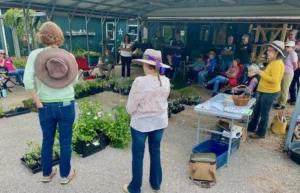Welcome to the La Bahia Chapter of NPSOT including Washington County and the five surrounding counties within its boundaries.
We are in both the East Central Texas Plains and Texas Blackland Prairies, divided between Austin and Houston, and includes plains, prairies, and woodlands landscapes. Our average rainfall is about 42 inches with peak rainfall usually in May and October, Hardiness Zone 9a.
Use the menus in the bar above to get more information relevant to our area, including plant lists, activities, and more.
You can use the interactive map to the right to learn more about our local ecoregions, and find your location. Zoom in to find your ecoregion. Click on an ecoregion for more details.
Please join us at a plant sale and/or swap, field trip, or other activity.
Upcoming Events
April No Frills Urban Garden Tour
9 a.m. – Saturday, April 20
We have four gardens lined up within two blocks on the south side of Tom Green Street between Market and Austin Streets in Brenham. Best parking will be in the 1400 block of S. Park near Molly’s house, which is in the middle of the other properties. There is also easy street parking on Church Street near Jenn’s, where we will start the tour.
Garden 1 – 9 a.m. 1402 Church St
(corner of W. Tom Green, across the street from the Alton Elementary parking lot)
Our tour starts at Jenn and Shawn McLoughlin’s “no dig” edibles garden. Jenn and Shawn co-own the online garden supply business All About the Garden and share their knowledge with nearly 13,000 Instagram followers (plus fans on a YouTube channel, a podcast and a Facebook page). Their large “no dig” food forest – a method they adopted from the British plants man Charles Dowding, based on building healthy soils — fills most of the lot beside the historic home they share with their four kids.
Garden 2 – 9:30 a.m. 104 E. Tom Green St.
Kristen Meaders’ beautiful cottage garden surrounding her 1930s bungalow combines natives, perennials, and vegetables, with an emphasis on pollinator plants. She is working her way gradually towards a complete unlawning. Kristen grows her own worms, so her soil is super healthy!
Garden 3 – 10 a.m. 102 E. Tom Green St.
Phyllis Danna shares a property line with Kristen, who is her cousin. Phyllis’s lovely yard is mannered and traditional – white picket fence and all — with a lovely mix of natives and perennials that support pollinators.
Garden 4 – 10:30 a.m. 1404 S. Park St.
Molly Glentzer’s garden has been evolving for 12 years. Last year she began the process of unlawning the front yard with as many natives as possible. She still lets alyssum take over the bare spots and has a weakness for old garden roses(about 20 varieties), irises and bulbs. The back is mostly lawn with borders of shade-tolerant perennials and natives, a rock swale, and a small container garden for vegetables. The emphasis throughout is on plants and trees that support pollinators and birds.
Native Plant Society Virtual Events
La Bahia Chapter News

New NICE Partner Nurseries and Event April 13
Saturday, April 13, The NICE Committee will set up a table at the Antique Rose Emporium to share information about selecting and growing native plants and promoting NPSOT. If you

Garden Signs Available
We’ve had a great response for the NPSOT Biodiversity and Members gate/garden signs. We still have 7 of the Biodiversity and 6 of the Members signs, $20 apiece, which will

Fall Plant Sale – Save the Date – October 5
La Bahia will hold it’s first native plant sale this fall. We have chosen Saturday, October 5, from 10 AM – 2 PM to begin this new tradition. We hope

Want to host a no frills tour?
Would you host a No Frills Garden Tour at your home/property sometime and spread your passion for gardening while sharing its beautiful results? Here’s the deal. On a day that

SAVE THE DATE: May No Frills Tour
Saturday, May 11 at 10 AMOne Big Sky Farm in Round Top MORE INFORMATION TO FOLLOW(We are working on a second No Frills Tour for May 25th.)

Spring Plant Swap Thanks
Thank you to John and Verna Lammers for hosting La Bahia’s Spring Plant Swap. Several members commented how there seemed to be more native plants than ever this time. Everyone
State Native Plant Society News

“Can’t See the Forest,” Renata Lucia in Exhibition
Many Society members have had interactions with our Administrative Assistant Renata Lucia since she joined the Native Plant Society of Texas staff in early 2022. However, not many may realize

Member News: Native Plants Thriving in Town Hall
By J.G. Domke, Fort Worth Chapter Good news: interest in and respect for native plants has been growing in the town of Flower Mound, just north of Grapevine in Denton

Power Plants for Pollinators
Monarch on Gregg’s Mistflower ( Conoclinium dissectum (syn. Conoclinium greggii ), Photo by Shaun McCoshum. By Shaun McCoshum, Ph.D, member at large Pollinator plants: you hear that term used a
